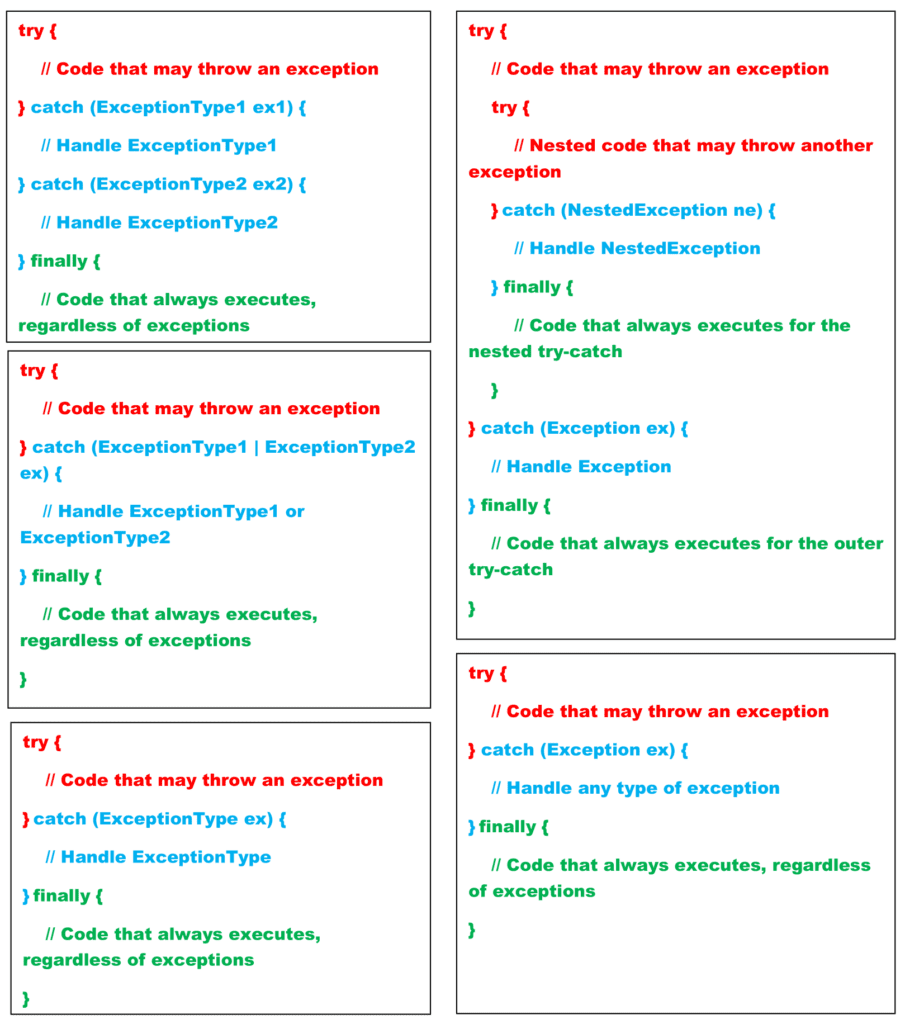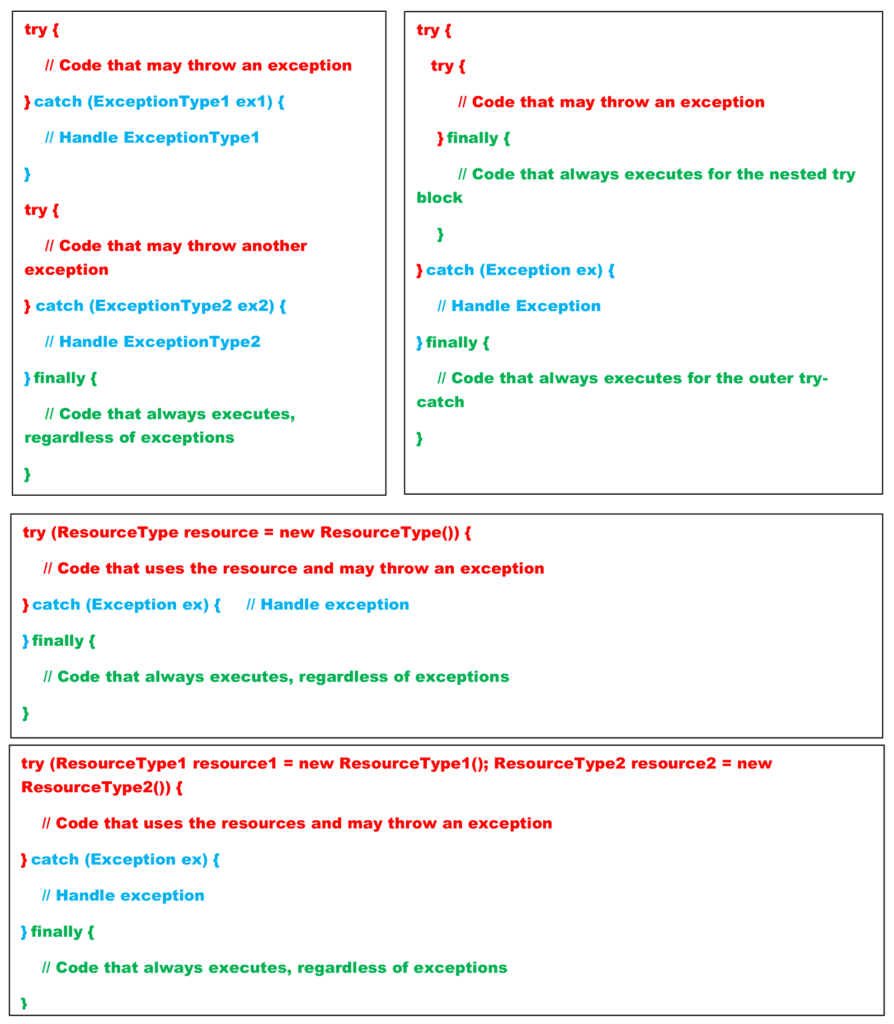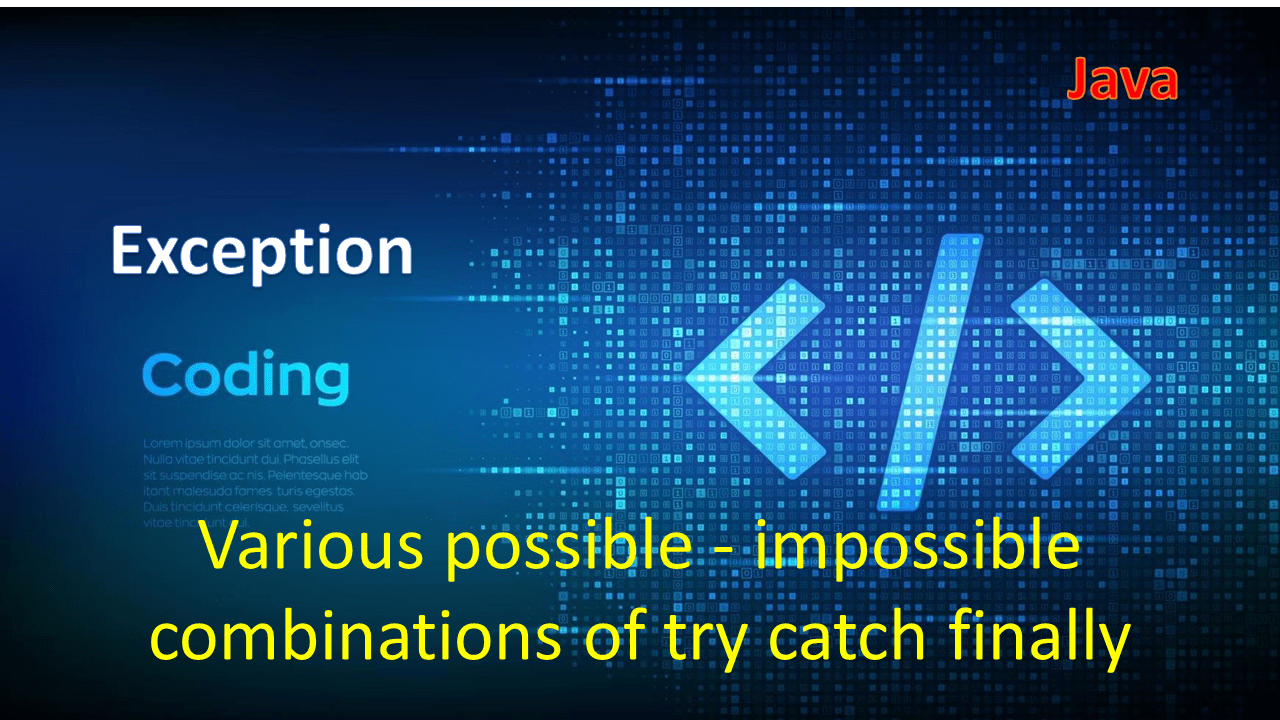In Java, there are various possible combinations of try catch finally blocks in different ways depending on your requirements. Here are a few possible combinations:


Explanation : possible combinations of try catch finally block
# What are the legal combinations of try catch and finally blocks ?
1. Simple try catch : possible combinations of try catch finally
try {
} catch (Exception e) {
// TODO: handle exception
}The code you provided is a basic structure of a try-catch block:
Here’s how it works:
- The code within the try block is executed.
- If an exception occurs during the execution of the try block, the program jumps to the catch block.
- The catch block catches the exception and specifies how to handle it.
- The catch block can access the exception object (in this case, represented by the variable “e”) to gather information about the exception, such as its type and message.
- After executing the catch block, the program continues with the code that follows the catch block.
Keep in mind that the code you provided is just a template and doesn’t perform any specific actions. In a real scenario, you would usually have code within the try block that may throw exceptions, and the catch block would contain the appropriate error-handling logic.
2. try with multiple catch : possible combinations of try catch finally
# multiple catch block in java
try {
// Code that may throw an exception
} catch (ExceptionType1 ex1) {
// Handle ExceptionType1
} catch (ExceptionType2 ex2) {
// Handle ExceptionType2
}The code snippet you provided demonstrates the usage of multiple catch blocks to handle different types of exceptions. Here’s how it works:
- The code within the try block is executed.
- If an exception occurs during the execution of the try block, the program checks the catch blocks in order.
- The catch blocks are evaluated sequentially, and the first catch block that matches the type of the thrown exception is executed.
- If the exception type matches the type specified in a catch block, the corresponding catch block is executed, and any code within that block is executed.
- If none of the catch blocks match the exception type, the exception propagates up the call stack until an appropriate catch block is found or until the program terminates if no matching catch block is found.
By using multiple catch blocks, you can handle different types of exceptions separately and provide specific error handling logic for each type. It allows you to have different exception handling strategies based on the specific exception type encountered.
In your code snippet, ExceptionType1 and ExceptionType2 are placeholders representing specific exception types. You would replace them with actual exception types you want to handle. For example:
try {
// Code that may throw an exception
} catch (IOException ex) {
// Handle IOException
System.err.println("IOException occurred: " + ex.getMessage());
// Additional error handling logic for IOException
} catch (SQLException ex) {
// Handle SQLException
System.err.println("SQLException occurred: " + ex.getMessage());
// Additional error handling logic for SQLException
}
3. try catch and finally : possible combinations of try catch finally
# write the syntax of try-catch-finally blocks
try {
// Code that may throw an exception
} catch (Exception e) {
// Handle the exception
System.err.println("An exception occurred: " + e.getMessage());
// Additional error handling logic
} finally {
// Cleanup operations or resource release
System.out.println("Finally block executed");
// Additional finally block logic
}The code snippet you provided demonstrates the usage of a try-catch-finally block. Here’s how it works:
- The code within the try block is executed.
- If an exception occurs during the execution of the try block, the program jumps to the catch block.
- The catch block catches the exception, and you can add code within it to handle the exception appropriately. In your case, you have a catch block that catches exceptions of type
Exception. You can replaceExceptionwith the specific exception type you want to catch and handle. - After executing the catch block, or if no exception occurs in the try block, the program proceeds to the finally block.
- The finally block contains code that is always executed, regardless of whether an exception occurred or not. It is typically used for cleanup operations or releasing resources.
- Once the code within the finally block is executed, the program continues with the code that follows the finally block.
4. two try-catch blocks one after the other : possible combinations of try catch finally
try {
// Code that may throw an exception
} catch (Exception e) {
// Handle the exception from the first try block
System.err.println("An exception occurred in the first try block: " + e.getMessage());
// Additional error handling logic for the first try block
}
try {
// Code that may throw an exception
} catch (Exception e) {
// Handle the exception from the second try block
System.err.println("An exception occurred in the second try block: " + e.getMessage());
// Additional error handling logic for the second try block
}
In the code snippet you provided, you have two try-catch blocks one after the other. Each try block is followed by a catch block. Here’s how it works:
- The code within the first try block is executed.
- If an exception occurs during the execution of the first try block, the program jumps to the corresponding catch block, which catches exceptions of type
Exception. You can replaceExceptionwith the specific exception type you want to catch and handle. - Within the catch block, you can add code to handle the exception appropriately.
- After executing the catch block, or if no exception occurs in the first try block, the program proceeds to the second try block.
- The code within the second try block is executed.
- If an exception occurs during the execution of the second try block, the program jumps to the corresponding catch block, which also catches exceptions of type
Exception. - Within the catch block of the second try-catch block, you can add code to handle the exception accordingly.
5. try with finally : possible combinations of try catch finally
try {
// Code that may throw an exception
} finally {
// Cleanup operations or resource release
System.out.println("Finally block executed");
// Additional finally block logic
}
In the code snippet you provided, you have a try block followed by a finally block. Here’s how it works:
- The code within the try block is executed.
- If an exception occurs during the execution of the try block, the program jumps to the finally block.
- The finally block contains code that is always executed, regardless of whether an exception occurred or not. It is typically used for cleanup operations or releasing resources.
- Once the code within the finally block is executed, the program continues with the code that follows the finally block.
6. try-catch-finally block with multiple catch blocks : possible combinations of try catch finally
try {
// Code that may throw an exception
} catch (ArithmeticException e) {
// Handle ArithmeticException
System.err.println("ArithmeticException occurred: " + e.getMessage());
// Additional error handling logic for ArithmeticException
} catch (Exception e) {
// Handle other exceptions
System.err.println("Exception occurred: " + e.getMessage());
// Additional error handling logic for other exceptions
} finally {
// Cleanup operations or resource release
System.out.println("Finally block executed");
// Additional finally block logic
}
In the code snippet you provided, you have a try-catch-finally block with multiple catch blocks. Here’s how it works:
- The code within the try block is executed.
- If an exception occurs during the execution of the try block, the program checks the catch blocks in order.
- The catch blocks are evaluated sequentially, and the first catch block that matches the type of the thrown exception is executed.
- If the exception type matches the type specified in a catch block, the corresponding catch block is executed, and any code within that block is executed.
- If none of the catch blocks match the exception type, the exception propagates up the call stack until an appropriate catch block is found or until the program terminates if no matching catch block is found.
- Regardless of whether an exception occurs or not, the code within the finally block is always executed.
- Once the code within the finally block is executed, the program continues with the code that follows the finally block.
7. nested try-catch blocks : possible combinations of try catch finally
# can you have a try catch within a try catch ?
try {
// Outer try block
try {
// Inner try block
// Code that may throw an exception
} catch (Exception e) {
// Handle the exception from the inner try block
System.err.println("An exception occurred in the inner try block: " + e.getMessage());
// Additional error handling logic for the inner try block
}
} catch (Exception e) {
// Handle the exception from the outer try block
System.err.println("An exception occurred in the outer try block: " + e.getMessage());
// Additional error handling logic for the outer try block
}
In the code snippet you provided, you have nested try-catch blocks. Here’s how it works:
- The outer try block encompasses the inner try block.
- The code within the inner try block is executed.
- If an exception occurs during the execution of the inner try block, the program jumps to the inner catch block.
- The inner catch block catches the exception of type
Exception(or any of its subclasses). You can add code inside this catch block to handle the exception appropriately. - After executing the inner catch block, the program continues with the code that follows the inner catch block.
- If an exception occurs in the outer try block (including the code following the inner catch block), the program jumps to the outer catch block.
- The outer catch block catches the exception of type
Exception(or any of its subclasses). You can add code inside this catch block to handle the exception appropriately.
8. try-catch block with a nested try-catch block in catch block : possible combinations of try catch finally
try {
// Outer try block
// Code that may throw an exception
} catch (Exception e) {
// Handle the exception from the outer try block
System.err.println("An exception occurred in the outer try block: " + e.getMessage());
// Additional error handling logic for the outer try block
try {
// Nested try block
// Code that may throw an exception
} catch (Exception y) {
// Handle the exception from the nested try block
System.err.println("An exception occurred in the nested try block: " + y.getMessage());
// Additional error handling logic for the nested try block
}
}
In the code snippet you provided, you have a try-catch block with a nested try-catch block. Here’s how it works:
- The outer try block contains the code that you expect might throw an exception.
- If an exception occurs during the execution of the outer try block, the program jumps to the outer catch block.
- The outer catch block catches the exception of type
Exception(or any of its subclasses). You can add code inside this catch block to handle the exception appropriately. - Within the outer catch block, there is a nested try block.
- The code within the nested try block is executed.
- If an exception occurs during the execution of the nested try block, the program jumps to the nested catch block.
- The nested catch block catches the exception of type
Exception(or any of its subclasses). You can add code inside this catch block to handle the exception appropriately.
9. try-catch block followed by a finally block, which itself contains a nested try-catch block : possible combinations of try catch finally
try {
// Code that may throw an exception
} catch (Exception e) {
// Handle the exception from the outer try block
System.err.println("An exception occurred in the outer try block: " + e.getMessage());
// Additional error handling logic for the outer try block
} finally {
// Cleanup operations or resource release
System.out.println("Finally block executed");
try {
// Nested try block within the finally block
// Code that may throw an exception
} catch (Exception e) {
// Handle the exception from the nested try block
System.err.println("An exception occurred in the nested try block within the finally block: " + e.getMessage());
// Additional error handling logic for the nested try block within the finally block
}
}
In the code snippet you provided, you have a try-catch block followed by a finally block, which itself contains a nested try-catch block. Here’s how it works:
- The code within the try block is executed.
- If an exception occurs during the execution of the try block, the program jumps to the catch block.
- The catch block catches the exception of type
Exception(or any of its subclasses). You can add code inside this catch block to handle the exception appropriately. - After executing the catch block, or if no exception occurs in the try block, the program proceeds to the finally block.
- The code within the finally block is always executed, regardless of whether an exception occurred or not. It is typically used for cleanup operations or releasing resources.
- Within the finally block, there is a nested try-catch block.
- The code within the nested try block is executed.
- If an exception occurs during the execution of the nested try block, the program jumps to the nested catch block.
- The nested catch block catches the exception of type
Exception(or any of its subclasses). You can add code inside this catch block to handle the exception appropriately.

Such innovation!
That is very interesting, You’re a very skilled blogger.
I have joined your rss feed and look forward to in search
of extra of yojr fanastic post. Additionally, I’ve shared
your website in my social networks https://tri1ls.webflow.io/
That is very interesting, You’re a very skilled blogger.
I have joined your rss feed and look forward to in search of etra off yoour
fantastic post. Additionally, I’ve shared your website in my social networks
Your writing style is engaging and informative. I’ve learned so much from this post and can’t wait to apply these tips to my own projects.
I appreciate how you broke down this complex topic into manageable pieces. Your clear explanations and real-life examples made it so much easier to understand.
Your expertise really shines through in this article. The practical tips and insights you’ve shared are going to be very useful for my work.